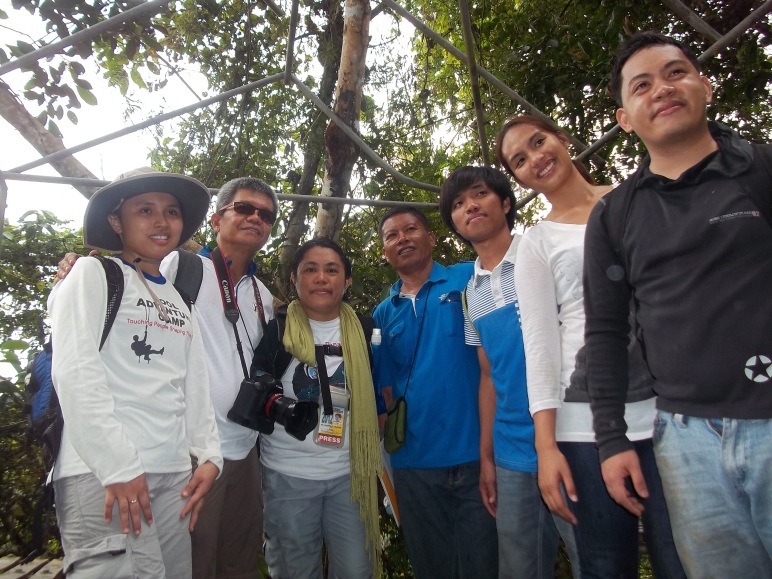by Maria Eleanor E. Valeros, #newmedia specialist
:for#microadventurism
caption: Selfie taken by Kyle Basalo with this writer, Janskie Libre, Raymund Rodrigo, Renzo Reoyan, Arvin Ska Gonzales, Earl Haha, and Kerwen Repoylo.
CENTRAL CEBU PROTECTED LANDSCAPE, PHILIPPINES — Even crazy ideas work.
My #NewNormal series of microadventure pursuits kicked off last year via a 44-kilometer Transcentral Road Moon Walk (or Luna Trek, after mythological claim that Luna is goddess of the moon). It happened as planned because though connecting with somebody who shares same interest is a challenge, the universe conspires beautifully to such scheme.
One day, in my routine commuting to Cebu City for my job, I happened to sit behind two young backpackers. The convergence inspired me to start a conversation. I learned they were from Talavera, Toledo City and were headed for Osmena Peak in Dalaguete town in southeast Cebu. From there, they would cross to Kawasan Falls (Badian town) via a five-hour hike.
If there’s an apt word to describe the camaraderie, I would call Renzo Reoyan and Kyle Basalo my ka-wavelength (of the same wavelength), ka-bandwidth (or sharing the same bandwidth capacity/coverage). We believe that even crazy ideas can work perfectly. We went to complete our very first Transcentral Moon Walk! Or the very first done on that part of earth.
Pain soused the journey, literally! The backbreaking uphill at the start of the walk and the steep downhill past Barangay Ga-as (part of Balamban) were just too much to bear. It was the silliest hike I’ve done in my life, 44 kilometers in 14 hours. We started late afternoon of Feb. 15, 2014 (Sat.), and reached Brgy. Aliwanay at Poblacion Balamban at the burst of a Sunday skyline. That’s about 3,300 feet for every kilometer covered!
Kyle’s foot hurt badly, so when I joked about a “return trip” (tackling the walk this time from Balamban back to Cebu City), he groaned at the idea. Or was it roared?
By December I realized it was more of a roar from a hiker with a lion’s heart.
It was December when he tagged me on FB a shirt design he made marked “The Walk First Anniversary,” so I was kind of surprised. I thought he would never ever sink his teeth again into the idea. But I was completely wrong, as there Kyle was preparing for the shirts, calling on his friends to join, preparing trail foods. And there I was tinkering on my keyboard not sure whether I should pledge for a “reverse walk.” I presume my ego was hiding somewhere, rolling its charcoal eyes at me, huffing and puffing with a litany of expletives. Should I say to Kyle, I’m outtah here? But Kyle’s desire is Medusa out of Zeus’ cranky head.
It was offbeat. It was off the beaten track. But the three of us committed to a “return trip” to seal a fact that we were the first bunch to do that – and to have done so both ways – undisputed in the annals of Cebuhumankind.
It was such an absurd idea indeed. We have not done it on a February 3 with a full moon. We did it on a 15th again which means Luna’s phase is headed to a new moon. So we can’t be on a pitch dark road for a long time. We decided to do it on broad daylight. And that was when I almost succumbed to heatstroke. I hate the timing, but love the company so much because it has grown to eight pax. There’s Arvie Ska Gonzales, Earl Haha, Raymund “Digoy” Rodrigo, Kerwen “Settle Bus” Repoylo for additions, and Janskie Libre, a friend I have kept since Bisrock days.
We failed to beat our record of 14 hours. We left Balamban at past 8 a.m. and reached JY Square in Lahug by 1 a.m. already. We had to rest a number of times along the way, seeking shelter at a DPWH field office at high noon. Newayz, we have mutually agreed to meet our goal. But also changed our bloody minds about any further transcentral walks. The anniversary already sealed a consumed effort.###
———————————————————————————————————————————
To join the second anniversary walk on Feb. 15, 2016, email me at eleanor.newmedia@gmail.com or FB: Eleanor Newmedia. Probable route: Mantalongon, Dalaguete-Alegria, south of Cebu.

